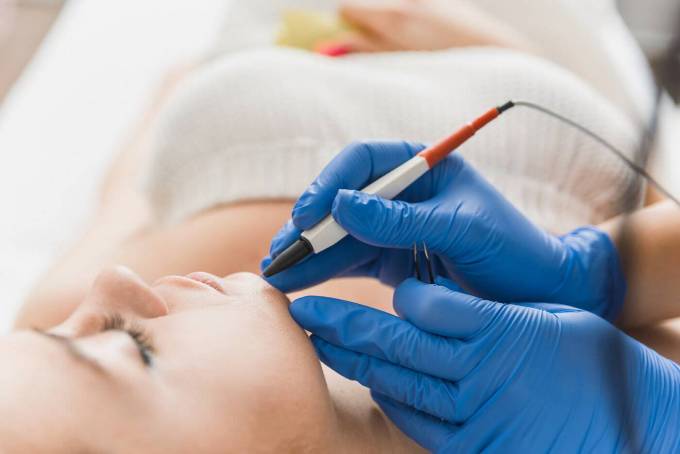How to Remove Skin Tags on Inner Thigh: Your Options
Published By Dynamic Clinic, 5 Oct 2024

Skin tags, also known as acrochordons, are small, benign growths of skin that often appear in areas where skin rubs against skin, such as the inner thigh. While they are harmless, many people prefer to remove them for aesthetic reasons or discomfort caused by friction. If you are considering How to Remove Skin Tags on Inner Thigh, here’s an overview of your options, ranging from home remedies to professional treatments.
Understanding Skin Tags
Before exploring removal methods, it's essential to understand what skin tags are. Skin tags are small, soft, and typically flesh-colored or slightly darker than your skin tone. They vary in size and often appear in clusters. Although they are non-cancerous and usually painless, they can become irritated due to rubbing against clothing or other skin surfaces.
Options for Removing Skin Tags
When it comes to removing skin tags on the inner thigh, several options are available. Here’s a breakdown of the most popular methods:
1. Over-the-Counter Treatments
Many OTC products are designed specifically for the removal of skin tags. These treatments can be effective for smaller skin tags and are generally considered safe when used as directed.
-
Cryotherapy Kits: These kits use freezing agents to freeze the skin tag, causing it to fall off over time.
- Usage: Follow the instructions carefully, applying the freezing agent directly to the skin tag for a specific duration.
- Effectiveness: Users often see results within a few days to a week, depending on the size of the skin tag.
-
Topical Solutions: Some OTC products contain ingredients that help dry out the skin tag, promoting its removal.
- Usage: Apply as directed, usually a couple of times daily.
- Effectiveness: Results can vary, with some users experiencing success within a few weeks.
2. Home Remedies
Some individuals prefer to try natural or home remedies before resorting to professional treatment. While these methods may take longer and results can vary, they are generally safe to try.
-
Apple Cider Vinegar: Its acidic properties may help dissolve the skin tag over time.
- Usage: Soak a cotton ball in apple cider vinegar and apply it to the skin tag. Secure it with a bandage for a few hours daily.
- Effectiveness: Results can take weeks, and some individuals report varying degrees of success.
-
Tea Tree Oil: Known for its antiseptic properties, tea tree oil may help dry out skin tags.
- Usage: Mix a few drops with a carrier oil (like coconut oil) and apply to the skin tag twice daily.
- Effectiveness: Like apple cider vinegar, it may take weeks to see noticeable results.
3. Ligation
Ligation is a simple and effective method that involves cutting off the blood supply to the skin tag.
- How to Perform:
- Use a clean piece of dental floss or string.
- Tie it tightly around the base of the skin tag, ensuring it’s snug enough to cut off circulation but not too tight to cause pain.
- Effectiveness: This method can effectively remove smaller skin tags, and they may fall off within a few days to weeks.
4. Cryotherapy
Cryotherapy can also be performed by a healthcare professional, who uses liquid nitrogen to freeze the skin tag.
- Professional Cryotherapy: This method is conducted in a clinical setting and ensures safety and effectiveness. The healthcare provider applies liquid nitrogen to the skin tag, freezing it.
- Effectiveness: Most skin tags fall off within a few days after treatment, and the procedure is quick and relatively painless.
5. Electrocautery
Electrocautery uses a small electric current to burn off the skin tag. This method is safe when performed by a healthcare professional.
- Procedure: The area is usually numbed with a local anesthetic before applying the electric current.
- Effectiveness: This method is quick and typically results in minimal scarring.
6. Surgical Excision
For larger or more bothersome skin tags, surgical excision may be necessary. This method involves cutting away the skin tag using a sterile scalpel.
- Procedure: This is usually performed under local anesthesia to ensure comfort.
- Effectiveness: Surgical excision is very effective and provides immediate results.
7. Laser Treatment
Laser treatment utilizes focused light energy to vaporize the skin tag. This method is precise and minimizes damage to surrounding tissue.
- Procedure: Conducted by a trained healthcare provider, this method is generally safe and effective.
- Effectiveness: The skin tag typically falls off within a week, and there is minimal risk of scarring.
Aftercare for Skin Tag Removal
After removing a skin tag, proper aftercare is crucial for optimal healing and to prevent infection:
- Keep the Area Clean: Gently wash the area with mild soap and water.
- Avoid Irritation: Wear loose-fitting clothing to reduce friction on the inner thigh.
- Monitor for Infection: Be alert for signs of infection, such as increased redness, swelling, or pus. If these symptoms occur, consult a healthcare provider.
- Follow Professional Advice: If a healthcare provider performed the removal, adhere to their aftercare instructions.
When to Seek Medical Attention
Consult a healthcare provider if:
- The skin tag changes in appearance (size, shape, color).
- You experience pain, bleeding, or irritation from the skin tag.
- Multiple skin tags develop rapidly.
- You are unsure whether the growth is a skin tag or something else, such as a mole or wart.
Conclusion
Removing skin tags from the inner thigh can be done through a variety of methods, both at home and professionally. Each option has its pros and cons, and the best choice depends on your specific situation, including the size and location of the skin tag. Whether you opt for over-the-counter treatments, home remedies, or professional procedures, prioritize safety and consult a healthcare provider if you have any questions or concerns. By understanding your options, you can confidently choose the best solution for your skin tags, enhancing your comfort and self-esteem.
